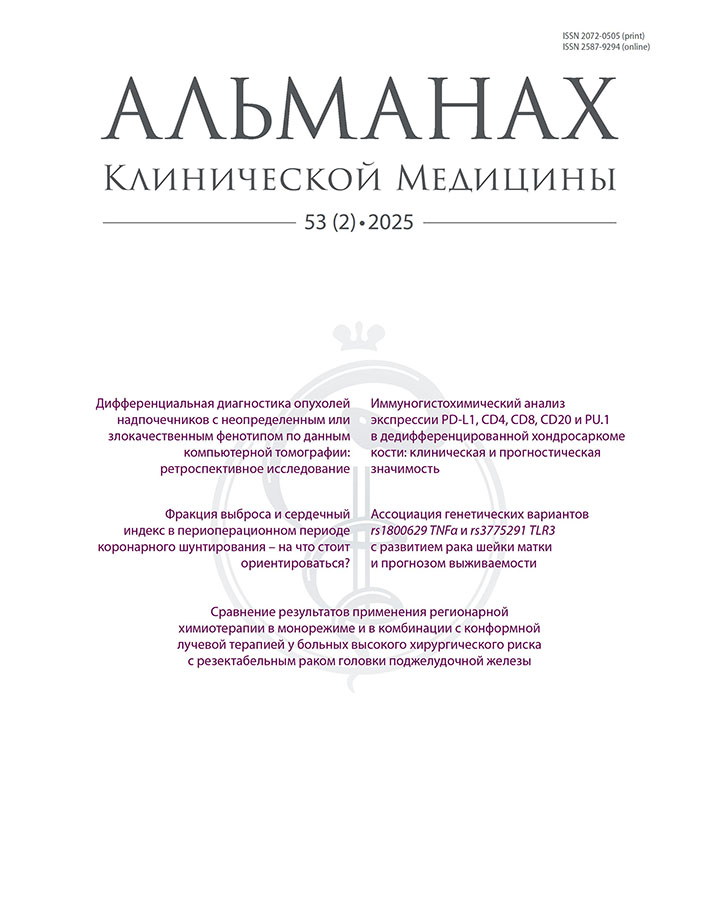Саркома Капоши с поражением век (6 клинических случаев)
- Авторы: Гришина Е.Е.1
-
Учреждения:
- ГБУЗ МО «Московский областной научно-исследовательский клинический институт им. М.Ф. Владимирского»
- Выпуск: Том 46, № 4 (2018)
- Страницы: 390-394
- Раздел: КЛИНИЧЕСКИЕ НАБЛЮДЕНИЯ
- URL: https://almclinmed.ru/jour/article/view/859
- DOI: https://doi.org/10.18786/2072-0505-2018-46-4-390-394
- ID: 859
Цитировать
Полный текст
Аннотация
Саркома Капоши – многофокусная опухоль из эндотелия сосудов с низкой степенью злокачественности, возникающая на фоне иммунодефицита и ассоциированная с вирусом герпеса 8-го типа. Саркома Капоши с поражением век наблюдается редко, и диагностика этой патологии вызывает затруднения как у офтальмологов, так и у онкодерматологов. В статье описаны 6 клинических случаев саркомы Капоши с вовлечением в патологический процесс век. У трех больных возник СПИД-ассоциированный тип опухоли. У одного пациента развился иммуносупрессивный тип на фоне приема иммунодепрессантов после пересадки почки. У двух больных пожилого возраста имелся классический тип саркомы Капоши. Опухоли век возникли через несколько лет после поражения кожи конечностей. Во всех наблюдениях была развитая (нодулярная) стадия саркомы Капоши век, в то время как поражение кожи конечностей было в виде пятен или папул (пятнистая или папулезная, начальная стадия заболевания). Опухоль кожи век выглядела как обширный опухолевый узел темно-красного цвета, четко отграниченный от окружающих тканей. Во всех случаях опухоль век была значительных размеров и мешала обзору. Все больные получали лечение у онкодерматолога и/или инфекциониста в зависимости от клинического типа заболевания. Саркома Капоши редко поражает кожу или конъюнктиву век, однако у больных с иммунодефицитом она должна быть включена в дифференциально-диагностический ряд опухолей век.
Ключевые слова
Об авторах
Е. Е. Гришина
ГБУЗ МО «Московский областной научно-исследовательский клинический институт им. М.Ф. Владимирского»
Автор, ответственный за переписку.
Email: eyelena@mail.ru
Гришина Елена Евгеньевна – доктор медицинских наук, профессор, главный научный сотрудник офтальмологического отделения
129110, г. Москва, ул. Щепкина, 61/2–11
РоссияСписок литературы
- Кубанова АА, ред. Дерматовенерология: клинические рекомендации. М.: ГЭОТАР-Медиа; 2006. 320 с.
- Antman K, Chang Y. Kaposi's sarcoma. N Engl J Med. 2000;342(14): 1027–38. doi: 10.1056/NEJM200004063421407.
- Беляков НА, Рахманова АГ, ред. Вирус иммунодефицита человека – медицина. Руководство для врачей. 2-е изд. СПб.: Балтийский образовательный центр; 2011. 655 с.
- Рассохин ВВ, Крестьянинова АР. Саркома Капоши. Диагностика и лечение. Практическая онкология. 2012;13(2): 114–24.
- Curtis TH, Durairaj VD. Ophthalmic Plast Reconstr Surg. 2005;21(4): 314–5. doi: 10.1097/01.iop.0000167783.06103.da.
- Bavishi A, Ashraf A, Lee L. AIDS-associated Kaposi's sarcoma of the conjunctiva in a woman. Int J STD AIDS. 2012;23(3): 221–2. doi: 10.1258/ijsa.2009.009144.
- Schmid K, Wild T, Bolz M, Horvat R, Jurecka W, Zehetmayer M. Kaposi's sarcoma of the conjunctiva leads to a diagnosis of acquired immunodeficiency syndrome. Acta Ophthalmol Scand. 2003;81(4): 411–3. doi: 10.1034/j.16000420.2003.00105.x.
- Молочков АВ, Казанцева ИА, Гурцевич ВЭ. Саркома Капоши. М.: Бином; 2002. 144 с.
- Dammacco R, Lapenna L, Giancipoli G, Piscitelli D, Sborgia C. Solitary eyelid Kaposi sarcoma in an HIV-negative patient. Cornea. 2006;25(4): 490–2. doi: 10.1097/01.ico.0000214212.37447.58.
- Kaposi M. Idiopathisces multiples Pigmentsarkom der Haut. Arch Dermatol Syph. 1872;3:265–73.
- Hong YK, Foreman K, Shin JW, Hirakawa S, Curry CL, Sage DR, Libermann T, Dezube BJ, Fingeroth JD, Detmar M. Lymphatic reprogramming of blood vascular endothelium by Kaposi sarcoma-associated herpesvirus. Nat Genet. 2004;36(7): 683–5. doi: 10.1038/ng1383.
- Gramolelli S, Schulz TF. The role of Kaposi sarcomaassociated herpesvirus in the pathogenesis of Kaposi sarcoma. J Pathol. 2015;235(2): 368–80. doi: 10.1002/path.4441.
- Radu O, Pantanowitz L. Kaposi sarcoma. Arch Pathol Lab Med. 2013;137(2): 289–94. doi: 10.5858/arpa.2012-0101-RS.
- Orenstein JM. Ultrastructure of Kaposi sarcoma. Ultrastruct Pathol. 2008;32(5): 211–20. doi: 10.1080/01913120802343871.
- Ciufo DM, Cannon JS, Poole LJ, Wu FY, Murray P, Ambinder RF, Hayward GS. Spindle cell conversion by Kaposi's sarcoma-associated herpesvirus: formation of colonies and plaques with mixed lytic and latent gene expression in infected primary dermal microvascular endothelial cell cultures. J Virol. 2001;75(12): 5614– 26. doi: 10.1128/JVI.75.12.5614-5626.2001.
Дополнительные файлы








